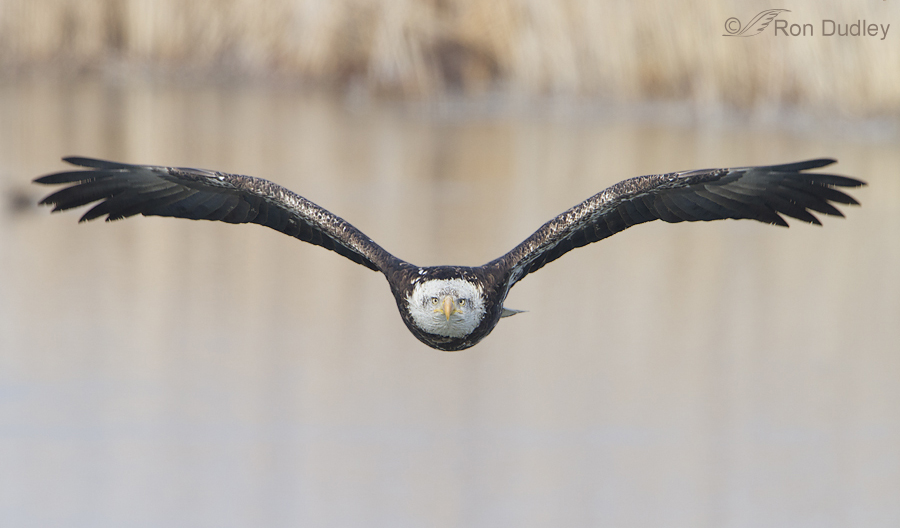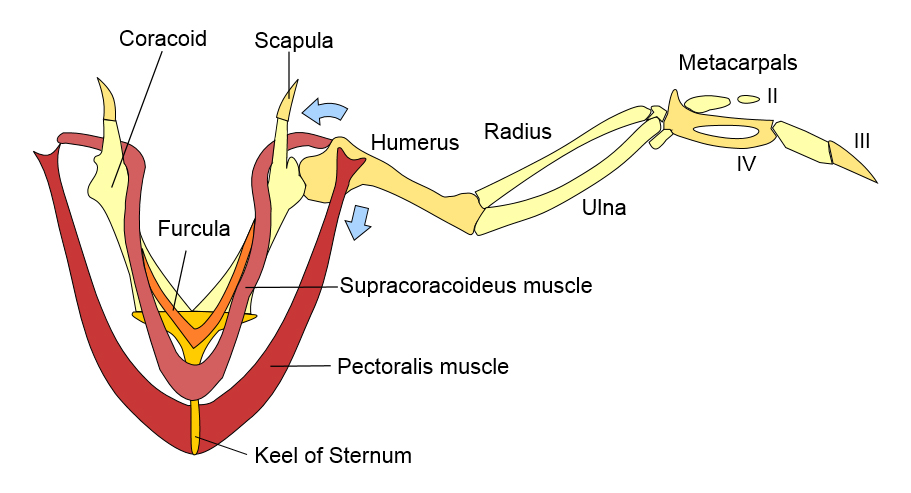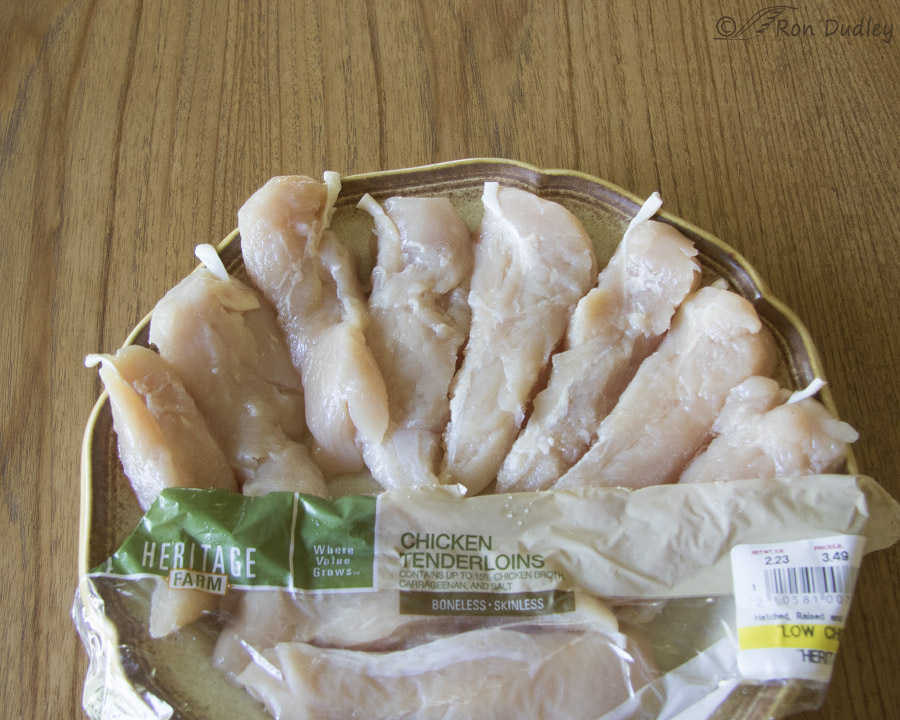Occasionally I rerun a favorite older post because many current readers have never seen it. I’ve been wanting to rehash this one, originally published on November 14, 2013, for some time so I could fine-tune it and see if I could do a better job of explaining a fairly complex subject. I’ve rewritten much of the text, added a photo and edited the formatting.
When I was teaching high school zoology I was fascinated by the many adaptations of birds for flight. I still am. One of them is a unique and fascinating muscle arrangement that allows the return stroke of the wing after the powered downstroke while still maintaining aerodynamic stability. I hope you’ll allow me a little change in direction with today’s post as I attempt to explain and illustrate one of the marvelous anatomical adaptations of birds for flight.

The Problem:
The body of a bird basically hangs down from the wings during flight. The wings attach high on the body for a reason – the huge and heavy breast muscle (pectoralis) lies below that attachment so this arrangement provides a low center of gravity, prevents the bird from being top-heavy in the air and provides aerodynamic stability. The pectoralis (flight) muscle attaches to the keel of the sternum and the humerus of the wing so when that muscle contracts it provides the powered down-stroke of the wing.
So one of the dilemmas of bird flight is how to design a muscle arrangement that will power the upstroke of the wing and still maintain that low center of gravity. It might seem logical that the muscle that would provide the upstroke would be along the back but such an arrangement would place a relatively large muscle mass high on the body and above the wing attachment, raising the center of gravity and compromising aerodynamic stability. Anyone who has ever eaten a chicken back knows that there’s very little meat (muscle) there which is evidence that natural selection came up with another solution.
And that solution is truly ingenious.
 By L. Shyamal [CC-BY-SA-2.5 (http://creativecommons.org/licenses/by-sa/2.5)], via Wikimedia Commons
By L. Shyamal [CC-BY-SA-2.5 (http://creativecommons.org/licenses/by-sa/2.5)], via Wikimedia Commons
The Solution:
In this graphic you can see how the contraction of the pectoralis muscle would power the wing down. But beneath and lying next to the pectoralis is another muscle – the supracoracoideus (that word is a mouthful, I know – it means “above the coracoid” bone). The supracoracoideus is antagonistic (a muscle that opposes another muscle – our biceps is antagonistic to our triceps) to the pectoralis and provides the upstroke. It is attached to the upper side of the humerus by a unique “rope and pulley” arrangement provided by a tendon that travels up and over a notch in the scapula before attaching to the humerus. So even though the muscle is below the humerus, the direction of pull is from slightly above so that when it contracts it raises the wing and aerodynamic stability is maintained by keeping the weight of the muscle down low.
Most folks are very familiar with the supracoracoideus, they just don’t know its formal name.

Chicken tenderloins or “tenders” are the supracoracoideus muscle of that domestic fowl. When we eat a chicken breast the supracoracoideus is the smaller and more tender piece of meat lying between the larger mass of the breast (pectoralis muscle) and the bone. If you’ve ever cooked chicken tenders at home you’ve likely noticed (and removed) the tendon coming off of the coracoideus. That tendon is the one that wraps over the notch in the scapula, attaches to the humerus and provides uplift to the wing. In this photo the tendon appears as a white stringy cord coming out of the top of the “tender”. You don’t want that little rascal stuck between your teeth (it’s tough as hell) so I always remove it before cooking.
I realize this post won’t be everyone’s cup of tea but I’m also aware that some folks (me included) like to know everything they can about their beloved birds. This post is for you…
Tomorrow I’ll get back to more standard fare.
Ron
Notes: The graphic above this last photo is misleading in a couple of ways (it’s the only appropriate Creative Commons graphic I could find). It shows a large space between the pectoralis and the supracoracoideus, a space that does not exist. The two muscles actually lie atop one another and are separated only by a very thin membrane. The graphic also shows the tendon to be as large in diameter as the muscle itself when in reality the tendon is something like a narrow string coming out of the much larger muscle as you can clearly see in the last photo.
Some may have also noticed the furcula in that graphic. The furcula is the “wishbone” but that’s a bird anatomy/physiology lesson for another day. I’ve probably thoroughly confused some of my readers already.
And yes, in answer to the obvious question, we’re having chicken tenders for dinner tonight…


My years-ago biology class didn’t cover this, so I do appreciate your excellent teaching re-post on this subject.
Upon rereading I see it was high school zoology you were teaching; I also took that class at Granger High and again at the U.
Ron’s teaching is so effective and fun that it actually gets me to think sometimes. After a long, hard day, reading all your great comments and responses has been more fun than a barrel of monkeys.
Thanks for the brightening!
fascinating, or Quite Interesting. ( the name of a British panel show which you would probably enjoy. -Also called Qi.Watch it on Youtube) but I digress. I LOVE it when you take us ‘behind the scenes’ as it were. Am always happy to learn more about our friends who own the skies.
.
Thank you, Gilly.
Late to the party – and heading out again shortly.
Is it just me? Your title immediately made me think Supercallaexpedocious (or however it is spelt).
Loved learning. And am very, very grateful. And also grateful that I gave up eating meat decades ago.
“Is it just me?”
Nope, Patty ran with that theme. Thanks, EC.
Ron, your terrible lol. I’m sure I would have thrown a Tomato at you for the cat comment, as I have always had cats. Beautiful picture. Thanks for the info!
I probably would have deserved the tomato, Jean. I teased my sisters mercifully about things like that.
Thanks Ron. Very interesting so clearly explained! I think I am going to give up eating chickens 🙂
I was afraid that photo might have that reaction on some, Joanne. 🙂
I remember when I was dissecting a cat for my anatomy class I’d always let my sisters and parents know the name of the muscle we were eating for dinner. My remarks often went unappreciated but I enjoyed the hell out of their reactions…
Well I’ve been thinking about going veggie for a while and that just might have helped me step over the line. It’s not that it grosses me out… it’s that I like the animals so much. Especially birds@
The furcula or “wishbone” as you mentioned is a very important part of the flying process too. It is a very unique bone in my opinion, It is very flexible and spring like. It adds extra snap to the flying process. And if broken it is almost impossible to heal correctly for proper flight like a spring there is a lot of tension on that bone, it needs to flex and be strong.
“it needs to flex”
Exactly, April – to the dismay of anyone who tries to break a wishbone without thoroughly drying it out first – using an oven or otherwise.
I love it when you teach. You do it so well!
The flight musculature of birds is a simply brilliant adaptation that’s utterly fascinating. The whole evolutionary divergence to make flight happen in the first place is just amazing and seriously miraculous! Looking back, you can almost hear those dinosaurs who are the ancestors of today’s birds saying, “Gravity is annoying. I’m outta here!”). It took LOTS of practice, not to mention the evolutionary adaptation itself, to make it all happen, but they persisted with many, many face plants in the process. Thus, persistence in the face of initial failure is a good thing, all things considered! Yes, my thought processes are often admittedly weird 🙂
One of the few regrets of my life is I didn’t study Latin when I had the opportunity, although I’ve tried to catch up from the errors of my high school days. I WANTED to take it but was advised that Spanish or French would be more useful. The first time that regret surfaced was when I toured the ancient churches, abbeys and other interesting places when I went to England in 1970. I have few regrets in this life, but that’s one of them.
Laura, I took high school Latin, so glad I did. It has helped me decipher more than English many times in my life.
Yeah, that was one of a strings of bad decisions on my part. In my dotage, I’ve learned that they happen with amazing regularity and the best thing you can do is claim them, move on and recover from them as soon as possible 🙂
I have the same regret, Laura. I think taking Latin should be very seriously considered by anyone who might possibly go into any science field.
Absolutely…or history! Since it’s the foundational basis for many of the romantic languages, it would help significantly across a variety of disciplines.
Wow. I’m also interested in Suzanne Mcdougal’s question about different flight styles. For example, turkey vultures seem to be constantly adjusting side-to-side, while eagles fly straight as a thrown stone. I always thought it had to do with the vulture’s lighter body weight, but now I wonder if it’s a matter of muscle anatomy. Thanks for a great lesson.
Betsy, it’s my guess that it might partly (at least in come cases) be related to anatomy but I just don’t know. There could be many other factors involved too, including a behavioral thing related to identifying their own species in flight, adaptations to hunting and life styles and a host of other possibilities. Who knows…
There’s a qualitative difference between the breast meat of the hard fliers (raptors, pheasants, pigeons, doves, etc.,) and the laggards like chickens. The meat of the hard fliers is redder and richer (more blood flowing through those muscles) than chickens who rarely fly. Some would say the redder meat is the healthier of the two. I know it’s the tastier if pheasants, quail and other game birds are an indicator.
As for raptor meat, obviously I wouldn’t want to eat one; however, I’d also opine that they’d be tough and hard to eat just because of who they are 😉
Very interesting information sbout the superfragilisticexpialidocious supracorecoideus….
Patty, I had to laugh at your comment, especially because your evil iPad seems to like complicated words just fine…
🙂 Bet you worked hard on that one, Patty – especially on your iPad…
Yet another reason birds are better than we are! Our pectoralis minor muscle just attaches to the coracoid process — slacker! 😉
Marty, I had to visit my physical therapist yesterday and I couldn’t resist asking him if he could guess what the supracoracoideus is based on the construction of the word. He already knew I was a bird photographer so after some thought he came pretty darned close.
Hi Ron,
Definitely my cup of tea. And, I remember the original post! I thought you did a great job the first time, but the chicken tenders do add a little muscle to the explanataion.😀
Cheers,
Dick
“the chicken tenders do add a little muscle to the explanataion”
Good one, Dick! I enjoyed it.
As Spock would have said (nerd alert), “Fascinating.” How does that influence the difference in movement and rhythm
that, for instance, raptor wings make in flight that makes the bird identifiable? Is that unique movement a construct of the supracoracoideus to body ratio or the wing placement or is this a stupid question?
Suzanne, it’s far from a stupid question but I don’t know the answer. Fascinating to ponder though…
I’ve seen an explanation of the flight muscles before, but it was good to experience it here. I like the way you explain things. And I never had any idea that chicken tenderloins were a separate muscle. Fortunately for me, all this makes sense because I have studied human anatomy, including cadaver dissection. And Latin words like ‘supracoracoideus’ are easy to say and spell (I had to take Latin, too). Thinking about the size of the two muscles, and the greater tenderness of the tenderloins on a chicken, it’s clear that it either takes less effort to raise the wings, or chickens don’t fly much. I’m wondering if that muscle would be as tender to eat on bird like raptors (not that I would want to eat a raptor).
Susan, in my experience (with bird dissections and from study) the relative sizes of the two muscles is always about like this. The power stroke requires much more energy, supplied quickly, than the return stroke. That probably explains the relative tenderness of the two pieces of meat too, although the supracoracoideus of any bird that flies regularly would probably be tougher than that of a chicken.
Thank you for that! 🙂
🙂
Scientific illustration is a challenge : to illustrate the parts clearly without skewing their actual relationship . As a college art major, I was directed away from that field because ,”in the future, it will
all be done with photography”—–which of course didn’t happen ! Your photo of chicken tenders is a good “illustration” of the reason why—-real life is beautiful, but subtle and MESSY !
Kris, as I’m sure you’re well aware many things can be illustrated much better with a graphic than with a photo, for a variety of reasons. And yes, real life certainly can be messy. It could be argued that it USUALLY is.
This is fascinating info explained so clearly. The tenders will always mean more now. Nature is indeed ingenious.
“The tenders will always mean more now”
I was a little hesitant to include that photo of them, Judy – for fear of turning folks off from eating chicken. Some readers might not appreciate me being that clinical with their food.
Great explanation of how that works, Ron! Once a teacher………….:) Also a reminder of how much can go wrong if things aren’t in their proper place and functioning as they should! Thx for sharing.
“a reminder of how much can go wrong if things aren’t in their proper place and functioning as they should!”
Boy, isn’t that the truth!
Well done, professor! A nice clear, concise explanation of avian anatomy- and I knew you’d mention the furcula! Thanks once again for an enjoyable post.
Diane, How could I NOT mention the furcula! 🙂
Fascinating, professor. As always. Thank you.
Thanks, Arwen.
Excellent explanation! Don
Thank you, Don.
Fascinating, Ron. Thanks. Birds are indeed aerial miracles. Always good to learn how a miracle works!
“Birds are indeed aerial miracles”
That’s a good way to put it, Sallie.